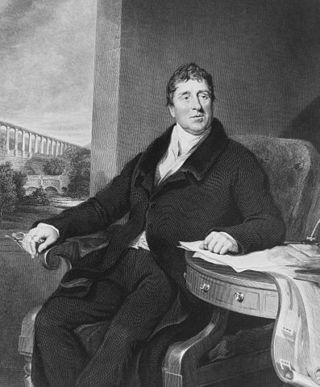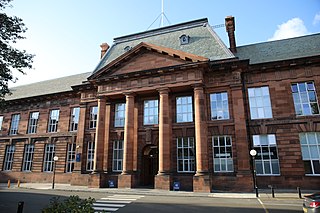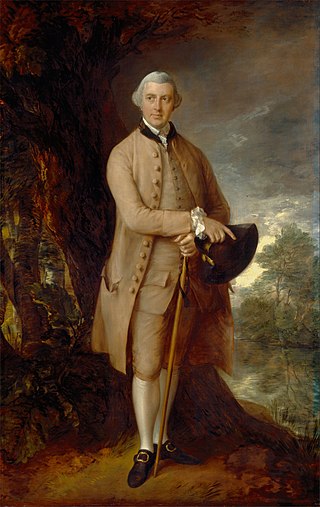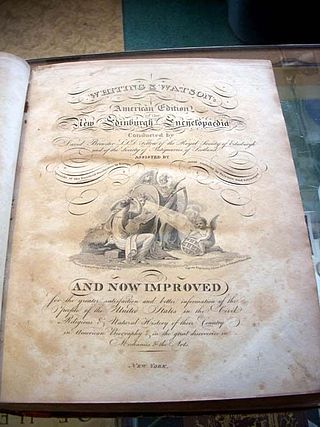Related Research Articles

Thomas Telford was a Scottish civil engineer. After establishing himself as an engineer of road and canal projects in Shropshire, he designed numerous infrastructure projects in his native Scotland, as well as harbours and tunnels. Such was his reputation as a prolific designer of highways and related bridges, he was dubbed the Colossus of Roads, and, reflecting his command of all types of civil engineering in the early 19th century, he was elected as the first president of the Institution of Civil Engineers, a post he held for 14 years until his death.

The Dean Cemetery is a historically important Victorian cemetery north of the Dean Village, west of Edinburgh city centre, in Scotland. It lies between Queensferry Road and the Water of Leith, bounded on its east side by Dean Path and on its west by the Dean Gallery. A 20th-century extension lies detached from the main cemetery to the north of Ravelston Terrace. The main cemetery is accessible through the main gate on its east side, through a "grace and favour" access door from the grounds of Dean Gallery and from Ravelston Terrace. The modern extension is only accessible at the junction of Dean Path and Queensferry Road.
The Royal Scottish Society of Arts is a learned society in Scotland, dedicated to the study of science and technology. It was founded as The Society for the Encouragement of the Useful Arts in Scotland by Sir David Brewster in 1821 and dedicated to "the promotion of invention and enterprise". The Society was granted a Royal Charter in 1841.

Edinburgh College of Art (ECA) is one of eleven schools in the College of Arts, Humanities and Social Sciences at the University of Edinburgh. Tracing its history back to 1760, it provides higher education in art and design, architecture, history of art, and music disciplines for over three thousand students and is at the forefront of research and research-led teaching in the creative arts, humanities, and creative technologies. ECA comprises five subject areas: School of Art, Reid School of Music, School of Design, School of History of Art, and Edinburgh School of Architecture & Landscape Architecture (ESALA). ECA is mainly located in the Old Town of Edinburgh, overlooking the Grassmarket; the Lauriston Place campus is located in the University of Edinburgh's Central Area Campus, not far from George Square.

Sir William Pulteney, 5th Baronet was a Scottish lawyer, Whig politician and landowner who sat in the British House of Commons between 1768 and 1805. One of the wealthiest Britons during his lifetime, he invested in the construction of several prominent buildings in Britain, including the Pulteney Bridge and other properties in Bath, Somerset, several beachfront residences in Weymouth, Dorset and roads in Scotland. Pulteney was also a patron of architect Robert Adam and civil engineer Thomas Telford. He also owned slave plantations in British America.

Brigadier-General Sir Alexander Gibb was a Scottish civil engineer. After serving as Civil Engineer-in-Chief to the Admiralty and Director-General of Civil Engineering at the Ministry of Transport, he established the engineering consultancy firm Sir Alexander Gibb & Partners.

Allan Glen's School was, for most of its existence, a local authority, selective secondary school for boys in Glasgow, Scotland, charging nominal fees for tuition.
The Smeatonian Society of Civil Engineers was founded in England in 1771. It was the first engineering society to be formed anywhere in the world, and remains the oldest. It was originally known as the Society of Civil Engineers, being renamed following its founder's death.

The Telford Medal is a prize awarded by the British Institution of Civil Engineers (ICE) for a paper or series of papers. It was introduced in 1835 following a bequest made by Thomas Telford, the ICE's first president. It can be awarded in gold, silver or bronze; the Telford Gold Medal is the highest award the institution can bestow.

The Institution of Engineers and Shipbuilders in Scotland (IESIS) is a multi-disciplinary professional body and learned society, founded in Scotland, for professional engineers in all disciplines and for those associated with or taking an interest in their work. Its main activities are an annual series of evening talks on engineering, open to all, and a range of school events aimed at encouraging young people to consider engineering careers.

The Edinburgh Encyclopædia is an encyclopaedia in 18 volumes, printed and published by William Blackwood and edited by David Brewster between 1808 and 1830. In competition with the Edinburgh-published Encyclopædia Britannica, the Edinburgh Encyclopædia is generally considered to be strongest on scientific topics, where many of the articles were written by the editor.

Sir Thomas Hudson Beare FRSE RSSA was a British engineer. He was successively Professor of Engineering at Heriot-Watt University, Edinburgh, at University College, London, and Regius Professor of Engineering at the University of Edinburgh.
Events from the year 1811 in Scotland.
Events from the year 1818 in Scotland.
Events from the year 1819 in Scotland.
Events from the year 1822 in Scotland.
Events from the year 1757 in Scotland.
References
- ↑ "Scottish Engineering Hall of Fame". Engineeringhalloffame.org. Retrieved 5 October 2013.
- ↑ "Scottish Engineering Hall of Fame Judges". Scottish Engineering Hall of Fame. Retrieved 5 October 2013.
- ↑ "About the Scottish Engineering Hall of Fame". Scottish Engineering Hall of Fame. 30 September 2011. Retrieved 5 October 2013.
- ↑ Mitra-Thakur, Sofia (2 September 2011). "Scottish Engineering Hall of Fame Launched". Engineering and Technology Magazine. The Institution of Engineering and Technology. Archived from the original on 4 March 2016. Retrieved 5 October 2013.
- ↑ "Hall of Fame Honours Scottish Engineers". Scottish Engineering. 9 December 2011. Archived from the original on 7 October 2013. Retrieved 5 October 2013.
- ↑ "Telford wins place in Scottish Engineering Hall of Fame". New Civil Engineer. EMAP Publishing. 13 September 2012. Retrieved 5 October 2013.
- ↑ "Engineers Celebrated In Scottish Engineering Hall Of Fame". University of Glasgow. 11 September 2012. Retrieved 5 October 2013.
- ↑ The engineer who forged ahead on long road to equality. The Times . 2 October 2012
- ↑ "Scottish Engineering Greats Inducted into Hall of Fame". The Courier . Retrieved 10 May 2013.
- ↑ "Scotland Tonight Celebrating Scotland's Rich Heritage of Engineering". Scottish Television . Retrieved 10 May 2013.
- ↑ "Scotland's Engineering Pioneers". Women In Science. 15 September 2013. Retrieved 5 October 2013.